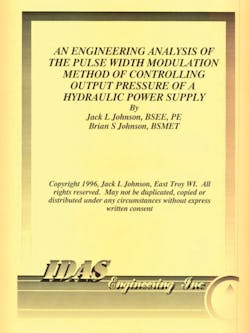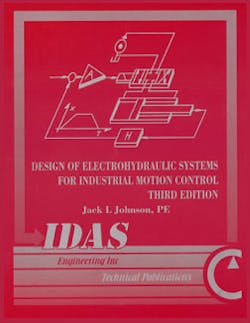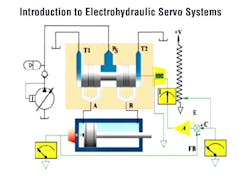Designers' Handbook for Electrohydraulic Servo and Proportional Systems, Fourth Edition, Jack L. Johnson, PE,
Handbook offers hundreds of pages of information, including details on how to calculate and control pressure losses in plumbing, subplates, and manifolds; how to analyze and control mechanical loads; valve dynamic properties; electronics (transducers, signal conditioning, etc.); and mobile equipment electrical systems, including batteries and charging systems.
For more information about the book or to ask a question about its content, email the author at [email protected].786 pages, hard cover book, $159.00Scroll to bottom of page to download an order form.
An Engineering Analysis of the Pulse Width Modulation Method of Controlling Output Pressure of a Hydraulic Power Supply, Jack L. Johnson, PE,
This is a detailed engineering study of a pressure compensated system that uses a fixed displacement pump, but NO relief valves (it IS as efficient as a conventional pressure compensated pump). You can read about the very complete test results, but more importantly, you can learn all that you need, to design and build your own low cost, but efficient constant pressure power units for both servo and conventional applications. Goodbye, variable displacement pumps.
For more information about the book email the author [email protected].
128 pages, soft bound, $39.95
Scroll to bottom of page to download an order form.
Lightning Reference Handbook
The popularity of this book — with over a quarter-million copies circulated — stems from the need for accurate, practical, comprehensive, and readily available data. This volume is a treasure trove of charts, tables, formulas, and other critical fluid power design information.
197 pages, soft cover book, $40.00
Scroll to bottom of page to download an order form.
Hydraulic System Analysis by George R. Keller, P.E.
Remastered from the fourth edition of George Keller's groundbreaking work from 1985, this timeless treatise covers everything from basic principles of pressure and flow to system dynamics. It is written in an instructional style, with hundreds of useful equations and sample problems at the end of many chapters. Although much of the product information is obsolete, the fundamentals and equations are as useful as ever.
210 pages, spiral-bound book, $50.00
Scroll to bottom of page to download an order form.
Basic Electronics For Hydraulic Motion Control, Jack L. Johnson
This book is written specifically by a practitioner of the hydraulic art for engineers and technicians working in the hydraulic art, and it teaches you all you ever needed to know about electronics. It covers transducers, interfaces, signal conditioners, pulse width modulation, controllers, amplifiers, transistors, analog electronics, digital electronics and more, much more. It is a must read and reference for anyone interested in certification in electronics.
For more a more in-depth description of this book, including a full table of contents, click here.
For more information about the book or to ask a question about its content, email the author at [email protected].438 pages, hard cover book, $99.00Scroll to bottom of page to download an order form.Fluid Power Systems and Circuits by Russell W. Henke, P.E.
Learn about circuit analysis and design flow for: constant and demand flow circuits, directional controls, pressure controls, and more. Completely illustrated and clearly written to show how to analyze interactions of system components and how to pull an entire design together to meet anticipated loads and operating requirements.
400 pages, hard cover book, $80.00
Scroll to bottom of page to download an order form.
Electrohydraulic Control of Pressure and Cylinder Force, Jack L. Johnson, PE,
Control of pressure is vital to controlling force or torque from actuators. It is subject to the constraints of the system non-linearities. This book presents all the mathematical wizardry needed to design effective, predictable and controllable pressure control systems by electrohydraulic means. It introduces ways to control gauge and differential pressure and also covers the problems associated with control of cylinder output force.
Click here for an in-depth description of this book, including a full table of contents.
For more information about the book or to ask a question about its content, email the author at [email protected].220 pages, soft cover book, $69.00Scroll to bottom of page to download an order form.Lexicon – Electrohydraulics and Motion Control, Jack L. Johnson, PE,
This illustrated lexicon is unique in that it is cross-referenced to related terms in the book. If the current definition contains an unfamiliar term that is in bold, merely look that term up and complete your understanding. It uses electric-hydraulic analogies so that you can use your own knowledge of hydraulic circuits and concepts to understand the electronic analogy. More than 700 terms are defined in this very comprehensive lexicon.
For more a more in-depth description of this book, including a full table of contents, click here.
For more information about the book or to ask a question about its content, email the author at [email protected].71 pages, soft cover book, $39.00Scroll to bottom of page to download an order form.Animated Video DVD: Introduction to Electrohydraulic Servo Systems, Jack L. Johnson, PE,
This animated video explains the basic function of the electrohydraulic positional servomechanism, the essential mechanism for modern electrohydraulic motion control systems.You will see through the art of animation the interaction of all the system components as the motion control system is put through its paces.This video is the easiest way to learn and understand the basic premises and operation
of otherwise complex machines. It’s intended for the novice.
A 60 question exam is designed to challenge your knowledge of not only concepts covered in the video, but general knowledge of hydraulic systems. But the challenge is done in a fun way, and we’ll supply all the correct answers whenever you are ready for them.















